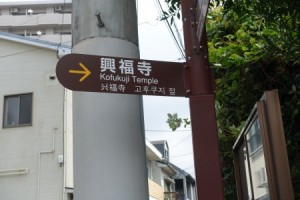
After visiting the Atomic Bomb Museum, the Hypocenter, and the Peace Park, it was time to see a different side of Nagasaki. We took the blue tram line #1 and got off at 32-Nishihamano-Machi. We were looking for a neighborhood that was notable for its temples. Before reaching this area, we strolled along the Nakashima River. Another blog will showcase what we saw during that walk. By using the Welcome to Nagasaki map, we came upon the sign that pointed toward the location of the Kofukuji Temple. The Kofukuji Temple website places the location on Teramachi-dori. The map does not provide a street name.
Kofukuji was the first Obaku Zen temple in Japan. Historians date the temple’s beginnings to 1620 when merchants from China’s Ming Dynasty (1368-1644) first traveled to Nagasaki. According to ancient customs, Chinese priests established shrines to pray for their followers’ safe travels. Eventually the expat Chinese community grew to approximately 15% of Nagasaki’s population. Thus, these Chinese businessmen and their religious institutions had an impact on Nagasaki’s history.
During the Japanese Edo Era (1641-1854), there were prohibitions against practicing Christianity. Thus, Chinese residents of Nagasaki chose to build temples to illustrate their Buddhist faith. Future blogs will focus on some of these neighboring temples. Kofukuji became a center for the practice of Zen.
All of the original structures were damaged or destroyed during the Great Nagasaki Fire of 1663. The renovated and rebuilt ones were later partially damaged at the end of World War II when the Atomic Bomb was dropped on Nagasaki. Later on, a few of the current buildings were relocated from other places. All of the buildings have historic and cultural significance.
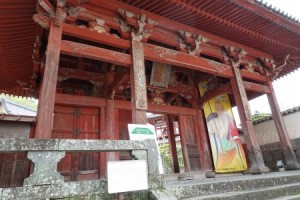
To enter the “red temple”, we walked through the opening of a weathered red structure. The San-mon is a single-story structure that is two bays deep. It is notable for its eight pillars, three doorways, and a hipped gable roof. Intricately carved ornaments are seen throughout. It is the largest temple gate in Nagasaki. This 17th century building was damaged by the atomic bomb, but was later restored. Calligraphy inside is inscribed with Chinese characters that mean “First Ascent to the Treasured Realm” and “Mountain of Eastern Light.”
After paying an admission charge, we were provided with a small pamphlet that included brief descriptions and a temple layout. There were only a handful of English signs on the property.
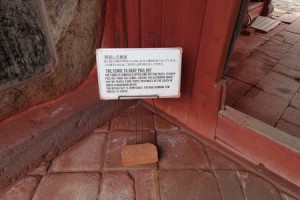
We chuckled at this sign as we crossed over this threshold. The sign explained that the threshold was used to keep pigs out.
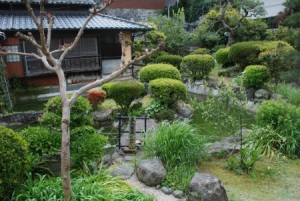
The grounds were immaculate and had mature foliage.
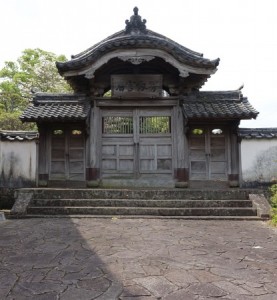
Maso-do (Mazu Hall) is sometimes referred to as “Heavenly Empress Mother,” the Chinese protector goddess of the sea. Chinese ships usually carried portable shrines to Maso. When the ships docked in Nagasaki the contents were transferred to worship halls. The ritual transfer included a lively parade and other festivities. The ceiling of this building is shaped like the inverted hull of a ship.
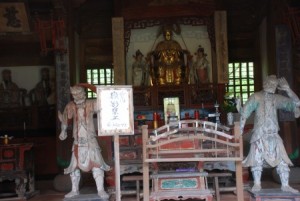
Inside the hall, Maso is seated in the center and several other deities are nearby. The two demons in the foreground have hidden powers. The first refers to “eyes that see a thousand leagues” while the second illustrates “ears that hear through the winds.”
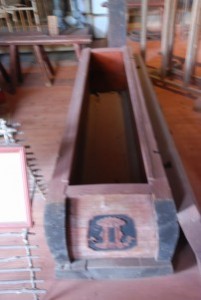
During the Edo Era (1641-1854), Japan was an isolated country. Nagasaki was the only open port and trade was limited to two outside nationalities- the Chinese and the Dutch. According to Chinese traditions, people would arrange for their coffins to be made while they were in good health and could pray for their own longevity. At Kofukuji,three to four carpenters built coffins for the Chinese population in Nagasaki.

As we walked through the grounds, I admired the Chinese styled architecture that included these wooden lattices.

The present Main Hall, the Daio Hoden, was rebuilt in 1883. Folding doors open into the main hall. The Chinese architecture also includes imported wood carvings and an ornate double styled roofed. The interior and exterior details are from the late Ming and Qing Dynasty
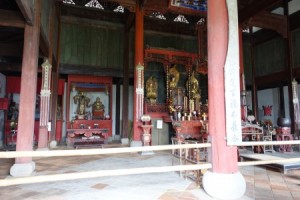
Inside the Main Hall are many carvings and deities. The Buddha Shakyamuni (Shaka Nyorai), is in the center. Images of people, birds, animals, and flora are carved onto the pillars and beams and “cracked ice” carved lattices surround the windows.
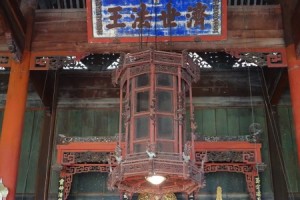
The glass lantern that is hanging from the ceiling in the Main Hall was imported from Shanghai. The lantern has intricate carvings of coiled dragons, human figures, and other motifs. It is the largest example of a 4 sided glass lantern in Japan. It dates back to the late Qing Dynasty.
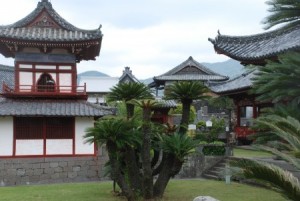
The structure has arched windows on all sides. There are demon faced tiles on the corners that face the San-mon Gate. These masks offer protection from any malevolent forces. On the corner tiles facing inward, a benevolent deity is present. It is unusual to see these tiles together. The official Kofukuji website for this temple believes that this is “a visual interpretation of the saying “Demons out! Happiness inside!”
Due to its off the beaten track location, we were able to tour this historic site with minimal distractions. We encountered only a couple of other tourists. It was a pleasure visiting a place that was not inundated with other people. If your looking for an historical landmark tied to 17th century Chinese culture in Japan, add Kofukuji Temple to your list of must see places in Nagasaki.
Related Posts
Precruise Exploration of Hong Kong
Fo Guang Shan Buddha Memorial Center
Sandra’s Bio
Sandra Bornstein is the author of MAY THIS BE THE BEST YEAR OF YOUR LIFE. It is available on Amazon. Sandra’s memoir highlights her living and teaching adventure in Bangalore, India. She is a licensed Colorado teacher who has taught K-12 students in the United States and abroad as well as college level courses. Sandra is married and has four adult sons. The memoir was a finalist in the Travel category for the 2013 Next Generation Indie Book Awards, the 2013 International Book Awards, the 2013 National Indie Book Excellence Awards, the 2013 USA Best Book Awards, and received an Honorable Mention award in the Multicultural Non-Fiction category for the 2013 Global ebook Awards.
Leave a Reply
You must be logged in to post a comment.